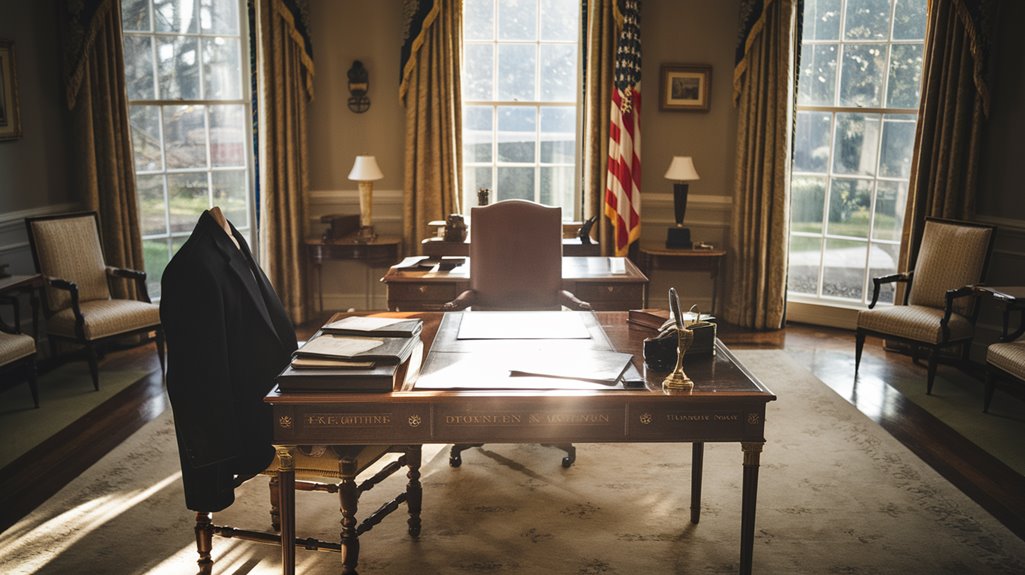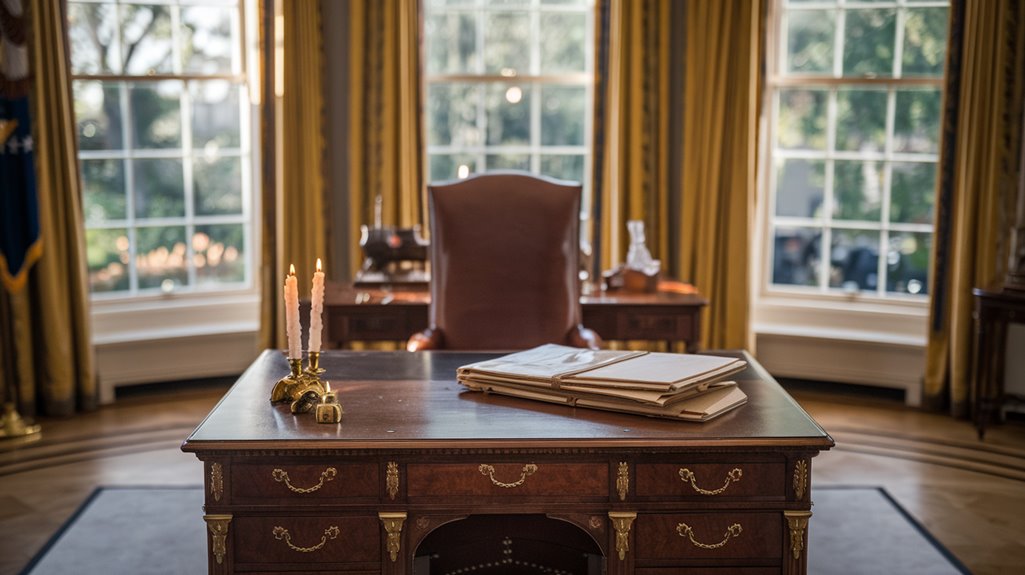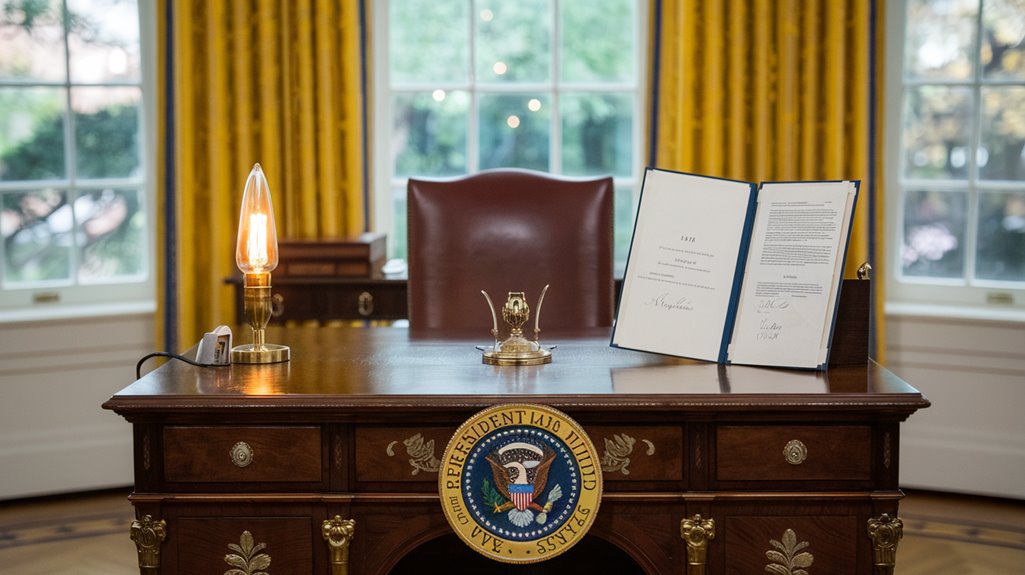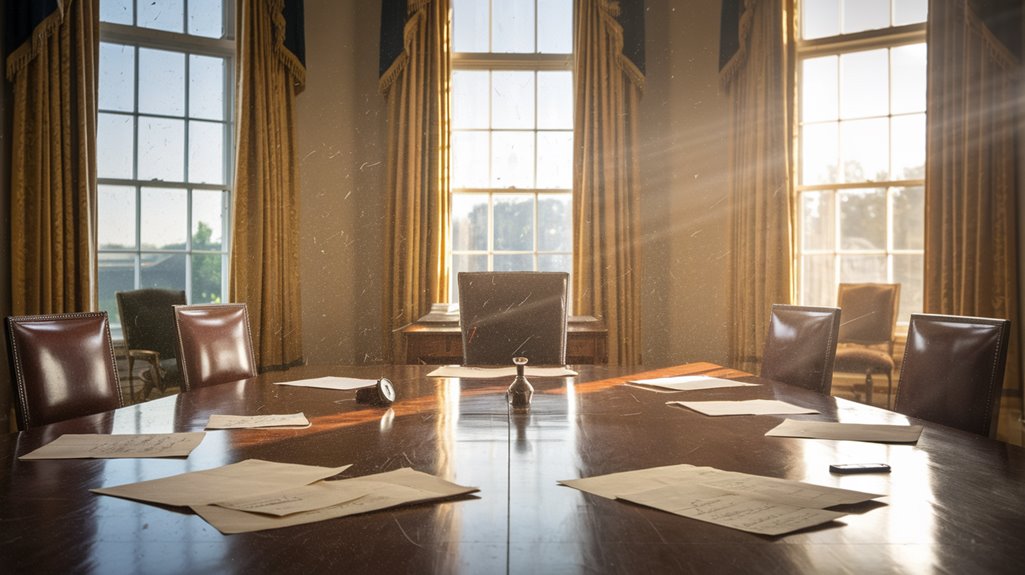John Tyler Was the First Unelected U.S. President
You've probably seen many changes of power in your lifetime, but in 1841, no one was quite sure what would happen when a U.S. president died in office. John Tyler's unexpected rise to the presidency came at the exact moment when the nation needed clarity on succession rules. While his critics mockingly called him "His Accidency," Tyler's bold response to this constitutional crisis would shape the future of American democracy in ways that still influence presidential changes today.
The Constitutional Crisis of 1841

When William Henry Harrison died just 31 days into his presidency in 1841, the nation faced its first constitutional crisis over presidential succession.
You might be surprised to learn that the Constitution wasn't clear about whether Vice President John Tyler should become the actual president or just an acting one.
Tyler didn't hesitate to assert his presidential authority. When his cabinet suggested he should serve as "Vice President acting as President," he firmly rejected this notion.
Instead, he took the presidential oath and claimed full executive powers. You'll find it interesting that both houses of Congress ultimately supported Tyler's position, despite initial resistance.
This established what's now known as the "Tyler Precedent," which finally brought succession clarity to the process. The precedent would later be formally codified in the 25th Amendment. As a former Virginia Governor, Tyler brought significant political experience to his unexpected role as president.
His decision to take the presidential oath on April 6, 1841 helped establish constitutional clarity during this unprecedented transition of power.
Tyler's Bold Claims to Presidential Power
After establishing himself as the legitimate president, John Tyler boldly exercised his authority in ways that shocked both Congress and his own cabinet. His constitutional interpretation left no room for doubt – he believed he possessed full presidential powers, not just those of an acting president.
You'll find that Tyler's executive authority was remarkably strong for someone who wasn't elected president. He vetoed more bills than any predecessor except Andrew Jackson, including major legislation like the bank bill and elements of Henry Clay's American System. This led to an unprecedented move when the House of Representatives initiated an unsuccessful impeachment effort.
When Congress resisted his claims to power, even suggesting constitutional amendments to limit his authority, Tyler stood firm. Despite fierce opposition, his actions proved that even a president without party support could exercise significant constitutional powers and block congressional majorities from setting domestic policy. His refusal to accept letters addressed as Acting President Tyler demonstrated his unwavering commitment to full presidential authority.
The Cabinet's Mass Resignation
Despite his initial claims to presidential authority, Tyler soon faced a dramatic showdown with his inherited cabinet. The cabinet dynamics reached a breaking point when Tyler vetoed several Whig-sponsored bills, particularly those aimed at establishing a national bank.
Led by Henry Clay's orchestration, all cabinet members except Daniel Webster resigned in protest in September 1841. You'll find this mass resignation reflected the deteriorating political alliances between Tyler and the Whig party.
In fact, the Whigs expelled Tyler just two days later, hoping to force his own resignation and replace him with Senate President pro tempore Samuel L. Southard. Instead, Tyler remained defiant and rebuilt his administration with southern conservatives, marking a decisive shift in his presidency.
The episode demonstrated both Tyler's resolve and the deep fractures within the Whig party.
From Vice President to "His Accidency"
The death of President William Henry Harrison in April 1841 thrust Vice President John Tyler into uncharted constitutional territory.
Though the Constitution mentioned the transfer of presidential powers, it didn't specify whether Tyler would become President or merely an Acting President.
Tyler's leadership was decisive and bold. He immediately claimed the full powers of the presidency, took the oath of office, and moved into the White House. Tyler met with Harrison's cabinet and invited them to stay.
When his cabinet suggested he serve as "Vice-President acting President," he flatly refused.
Political opposition was fierce, with critics mockingly calling him "His Accidency." Senator Henry Clay viewed Tyler's presidency as a "regency," while John Quincy Adams argued for a caretaker role. At just fifty-one years old, Tyler became the youngest man to assume the presidency.
Despite the resistance, Tyler wouldn't back down. He even returned unopened mail addressed to "Acting President," cementing a significant precedent for future presidential successions.
Legacy of Presidential Succession

While John Tyler's bold actions established the initial precedent for presidential succession, subsequent legislation and constitutional amendments have refined and strengthened America's transfer of executive power.
Congress has repeatedly updated succession laws to guarantee stability in times of crisis, with major revisions in 1886 and 1947 reshaping how presidential authority passes to new leaders. The delegates at the Constitutional Convention devoted minimal time to addressing presidential succession details.
Key developments that built upon Tyler's precedent include:
- The 1886 Act's shift to cabinet succession, removing legislative officers
- The 1947 Act's reinstatement of the Speaker and Senate President Pro Tempore
- Eight successful implementations of Tyler's precedent before formal codification
- Constitutional recognition through the 25th Amendment
- Evolution from Tyler's "His Accidency" status to today's clear transfer protocols
When President Harrison died just 32 days into his term, Tyler became the first vice president to assume the full powers of the presidency.
These changes transformed Tyler's controversial claim to power into established constitutional practice.
The Tyler Precedent in Modern America
Modern presidential successions follow clear protocols thanks to John Tyler's bold interpretation of constitutional powers in 1841. His precedent established that Vice Presidents who assume the presidency receive full presidential authority, not just acting powers.
You'll find this principle codified in the 25th Amendment, which provides succession clarity for the modern era.
While Tyler faced harsh criticism and mockery as "His Accidency," his actions have proven invaluable for maintaining government stability. Since Tyler's time, eight Vice Presidents have assumed the presidency, and each shift has occurred smoothly because of the clear standards he established.
Though historians often rank Tyler among the less successful presidents, you can't deny his lasting impact on American democracy through this vital constitutional interpretation. His presidency demonstrated the critical importance of having qualified vice presidents in office, as Harrison's unexpected death thrust Tyler into a role many felt he wasn't prepared for. As a member of the Whig Party, Tyler faced significant political challenges when he vetoed much of his own party's legislative agenda.











